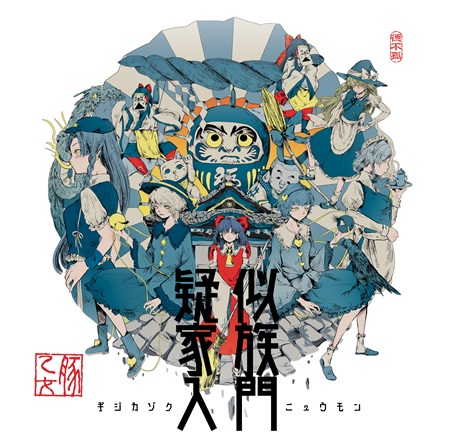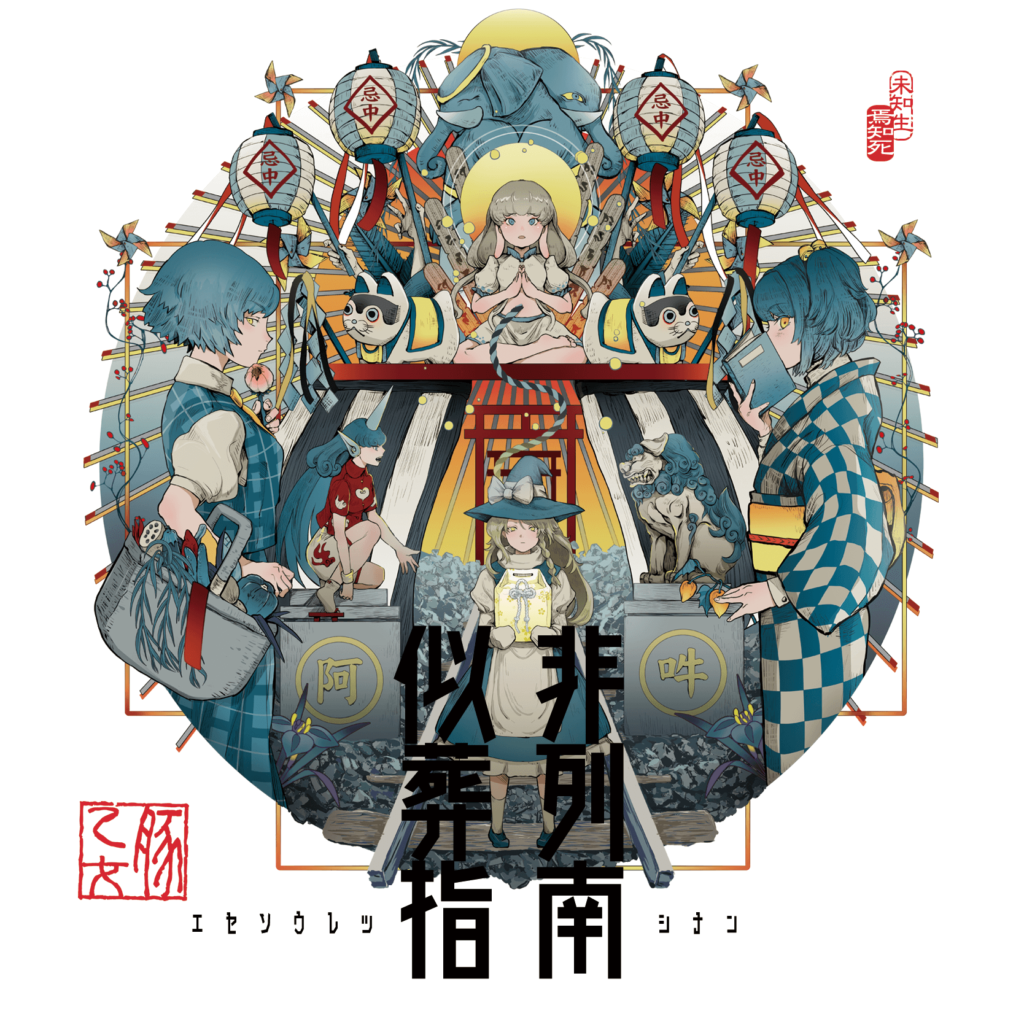A post I just wanted to write. I’m very hyped about this album, and I think the last time I was genuinely excited about a BUTAOTOME vocal release was with Trauma Recorder. Or Daihinmin. Anyway!
So, why am I so excited about Ese Souretsu Shinan? Well, because BUTAOTOME VIOLET DETECTOR IS REAL, the curse has ended, yahoo!!!!11 Okay, there are other, more serious reasons. First of all, this is the first time we get an album strictly linked to an older one and not released in a short time frame (Daifugou was released 3 months after Daihinmin, while here there is a 3 years gap between Nyuumon and Shinan). Note that I said “linked”, not “a sequel”. Because if it was a sequel of Giji Kazoku Nyuumon, the Pig would have called it “Giji Kazoku Nyuumon vol.2” or something. Furthermore, the official sources so far don’t mention Giji Kazoku at all, not even a tweet about it. Maybe the members will say something in a future blog post. But the references are kinda obvious to the eye. Giji Kazoku Nyuumon is not one of my favorite albums, but this surprising choice of making an album with the same exact design of a previous one (and it’s not a Shoujo Rengoku album!) makes me very excited.
The other reason I’m hyped for this album is that it sounds so good. The sound reminds me of BUTAOTOME’s original stuff, (well, actually most of Comp’s tracks) and the majority of the tracks don’t sound like generic Touhou arrangements, the melody has been adapted nicely (or they are just themes I didn’t hear at least 10 other songs based on them before). And the rearranged songs! Yukueifumei no and Good Meister are two songs I really like, and these Paprilicious takes on them sound promising.
In this post, I want to analyze what we know so far about Ese Souretsu Shinan, compare it with Giji Kazoku and talk about what I expect from each song.
First of all, the titles. Giji Kazoku Nyuumon VS Ese Souretsu Shinan. 疑似家族入門 VS 似非葬列指南. Six kanjis, three words. Both 疑似 and 似非 mean “false, pseudo, mock”. 入門 means “introduction, primer” and 指南 means “lessons, instructions (for arts)”, both words have a teaching motif. And at last, the two middle kanjis, referring to something about the album: 家族 (family) and 葬列 (funeral procession).
On the cover of both albums, we have quotes from Confucius: “virtue (or the man of virtue) is not left to stand alone, he who practices it will have neighbors.” (GKN) and “while you do not know life, how can you know about death?” (ESS). I admittedly know nothing about Confucianism, so Google-san is helping me a lot. According to his philosophy, the family is where we start to build up our virtues, and good family relationships are what make proper behavior. And with good virtue, you get more relationships with people. He also didn’t want to think about the afterlife. Confucianism respects the notions of ghosts, deities, etc…. But no need to discuss it, because life is more important.
I think Ese Souretsu Shinan will be one of those albums where lyrics play a very important part in the album concept, more than recent BUTAOTOME Touhou vocals. Giji Kazoku was one of them, after all. That album had a family/growing up motif through all the tracks. Reimu and Marisa’s friendship, the bond between Satori and Koishi, Flandre, her destructive powers and how they affect her relationships with people, Shinki seeing little Alice growing up.
Now, let’s analyze each track from the upcoming album. I’ll also try to translate the lines I managed to understand (note: I’m not a super cool person who can 100% grasps sung Japanese lyrics without a booklet. Also, there might be errors).
Karisome Kizuna, Yurikago no Naka de and the two rearranges would be part of a group of Reimu (and Marisa) songs. We have three tracks that use Reimu-related themes, but she doesn’t appear on the cover, which leads me to think she is dead (due to the “funeral procession” theme thing and “those who aren’t here now” in the description). This may be supported by the fact that there is a couple of recurring kanjis in the cover: 忌中, mourning. This word refers more specifically to the Asian funeral ceremony/rite that lasts for 49 days.
Ranko wrote lyrics for the two new tracks on this group, so I hope she will write her commentary in a future blog post!
Speaking of the two rearranges… Good Meister is basically a Marisa being Marisa song, and I wonder if it will get a different shade with this new version, but I’m having issues with interpreting Yukuefumei no. Perhaps, in the context of the album, it will reveal Reimu’s fate.
Next on the line, we have Occultic Dreamer. I can’t help but think this might be the Sumireko track that was originally planned for Magic Lantern (before they decided to troll us). Just my speculah, because maybe BUTAOTOME really wanted to have an ULiL credits arrangement for that album since the beginning! Anyway, what I get from the lyrics of Occultic Dreamer might fit with the celestial theme of Magic Lantern. I don’t know how it will fit into Ese Souretsu, maybe it will be about Sumireko leaving behind Gensoukyou and the Hifuu Club?
“a different world is still spreading on the other side of the world
*something something sky, something jump*
the map I drew is my sole treasure that I will embrace and love”
Aoi Ame is an arrangement of Plastic Mind, one of Alice’s themes. Alice is the only character from Giji Kazoku Nyuumon that reappears in this album (excluding Reimu and Marisa). Comp wrote the lyrics for this one, so I think it will be a sequel of/connected to Sorairo Ribbon. I grasp nothing from the sung lyrics except for the title.
Next is the only Paprika song in the album (excluding rearranges): Haikei, Anata no Omoide. When I first read the title, I thought of a Shinra-Bansho song called “Haikei, 100nengo no Watashi ni.” (拝啓、100年後の私に。). I’m perfectly aware that they don’t have the copyright on a title starting with 拝啓, it’s just that it’s not a word I see very often on lyrics, let alone song titles. Plus the Shinra-Bansho song is an arrangement of Child of Are (Akyu’s theme), while Anata no Omoide is Bibliophilie with a Deciphering Eye (Kosuzu’s theme). Akyu is paired with Kosuzu 90% of the time, and the other way around. The other part of the title of the Butasong is “your memories”, and memories are the most basic thing associated with the Hieda family. So, I can’t help but think this will be an AkyuSuzu song, with reincarnation stuff and such.
“do you still remember the words of our promise?
if you carve out a living proof, we’ll laugh with the future”
Last but not least we have Toketa Inori, an arrangement of Jelly Stone, Eika’s theme. The album description mentions “those who aren’t born”. Eika is the spirit of a stillborn child. Self-explanatory!
And that’s all for this rambling. I may have said a bunch of bullsheet. The full review and analysis of this album will come out once I will get it!

